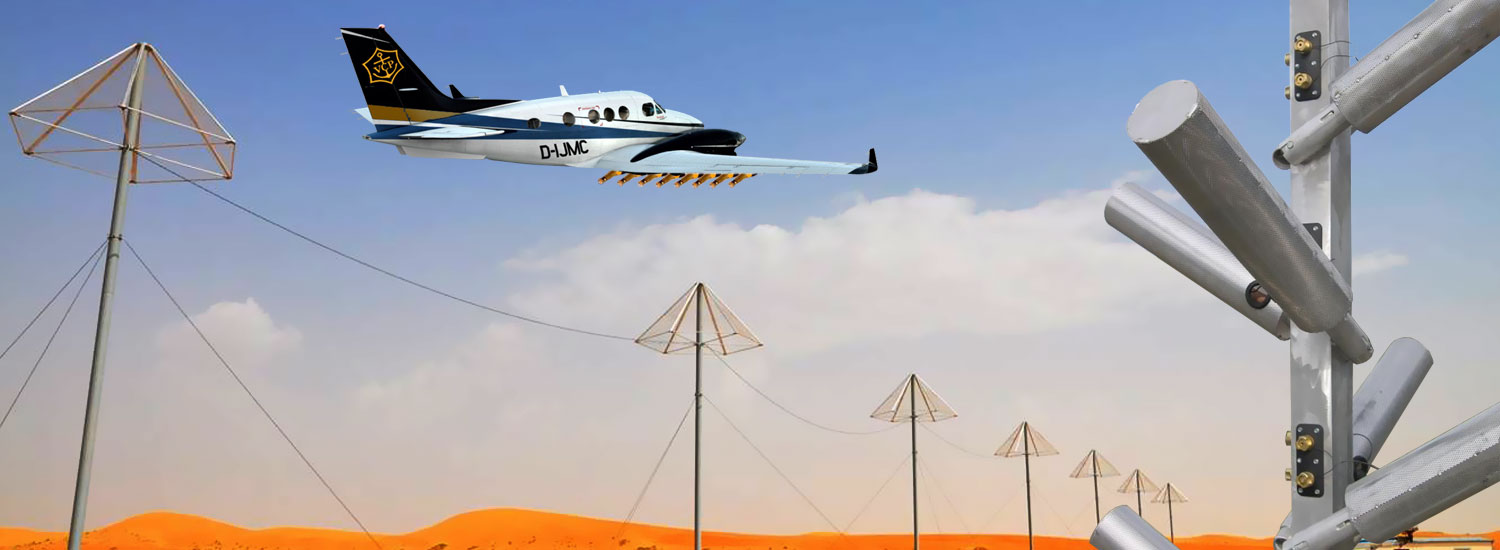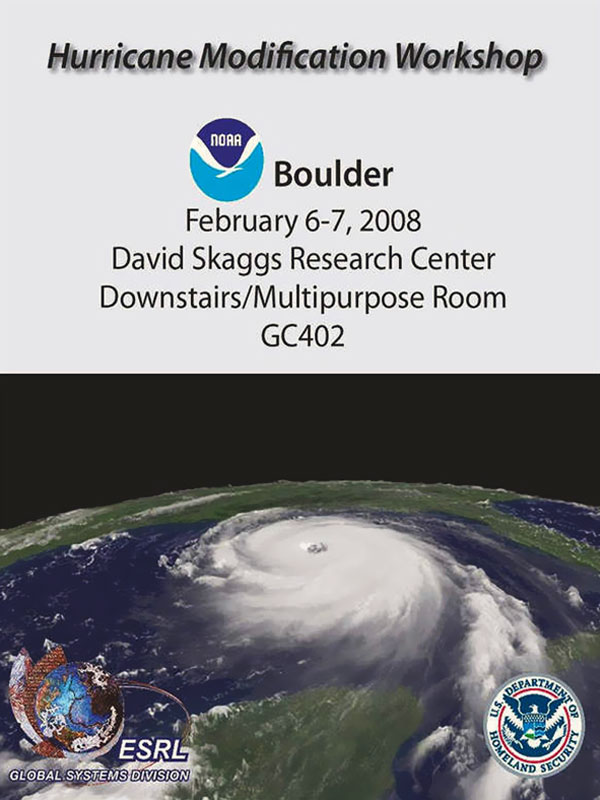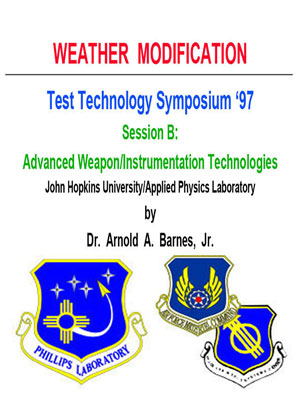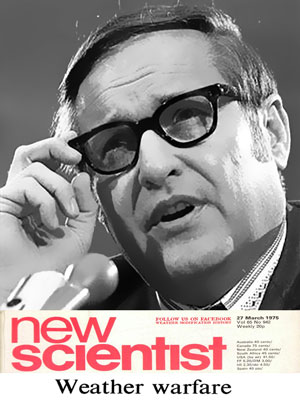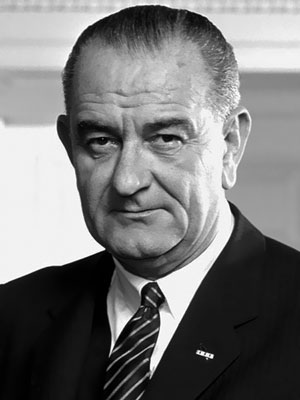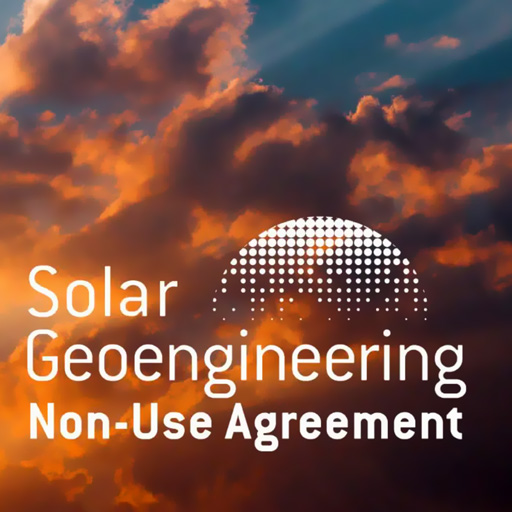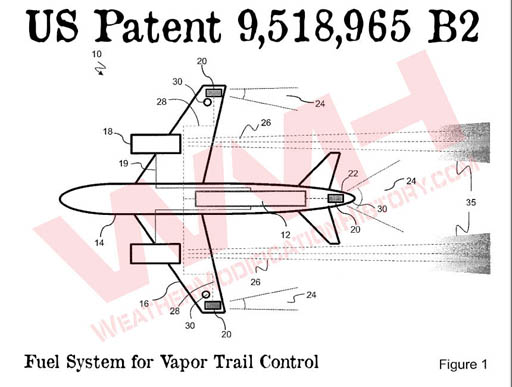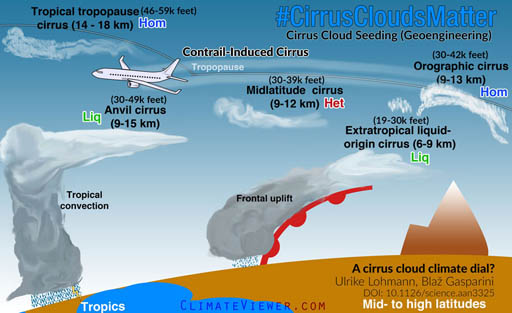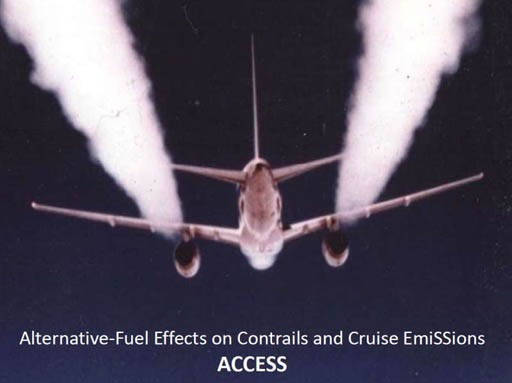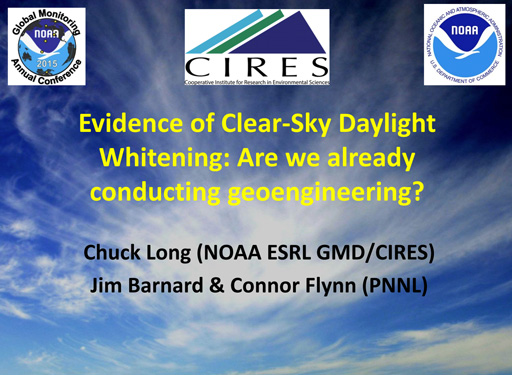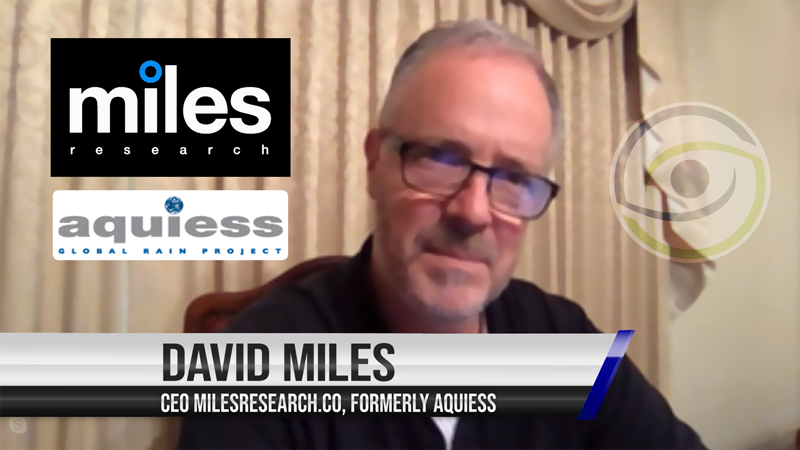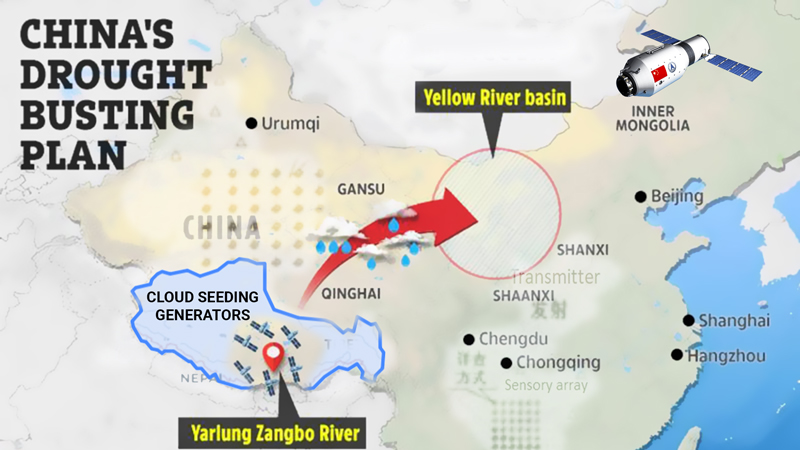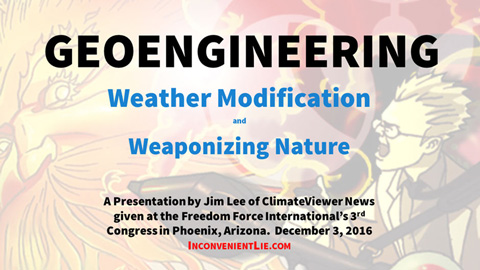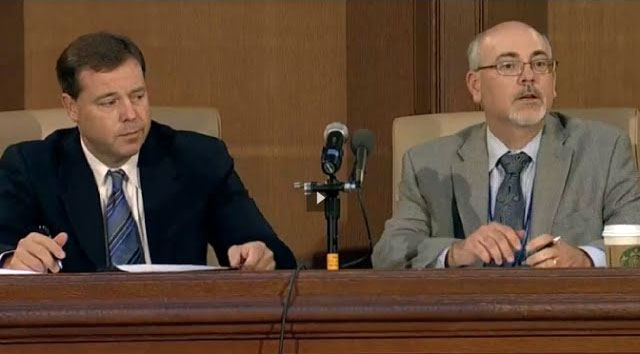Weather modification is a worldwide industry with airplane and ground-based cloud-seeding generators burning chemicals to add more seeds to clouds with the hope that these aerosols will create rain, snow, or even make hail smaller. Billions of dollars are spent each year on this completely unpredictable practice. In the sections below you can learn the terminology, see government reports of actual weather modification experiments, check out weather modification conferences, read a list of weather modification patents, and see a corporate roster of companies involved in controlling your weather.
Presentations
Technology
Vincent Schaefer, Irving Langmuir, and Bernard Vonnegut invented cloud seeding November 13, 1946 at the General Electrics Laboratory. The idea behind cloud seeding is actually very simple: add cloud condensation nuclei to rain clouds and produce additional rainfall. In practice cloud seeding has never produced scientific proof of predictable results (efficacy). Glaciogenic Cloud Seeding involves the injection of ice-producing materials into a supercooled cloud to stimulate precipitation by ice particle growth. The objective of glaciogenic seeding is to introduce seeding material that will produce the optimum concentration of ice crystals for precipitation formation. This is usually achieved by planes burning pyrotechnic flares that release silver iodide. The intent of glaciogenic seeding of orographic clouds (or clouds that develop in response to the forced lifting of air by topographical features on the earth's surface) is to introduce aerosol into a cloud to alter the natural development of cloud particles and enhance wintertime precipitation in a targeted region. This is usually achieved by ground based cloud seeding generators that release silver iodide into clouds using updrafts near mountains.
Uses
- Precipitation Enhancement: Addition of aerosols to increase rainfall.
- Decrease Precipitation: "Over seeding" could result in less, or no rainfall depending on the amount of cloud seeds introduced and the amount of available water vapor or flooding further downwind once enough water vapor condenses on the cloud seed plume. See: Thai Cave Rescue: Cloud Seeding to Stop Monsoon Rains? • Chinese Weather Modification at the Beijing Olympics • Russian Cloud Seeding Prevents Chernobyl’s Radioactive Rains Reaching Moscow
- Hail Suppression: Reduce the size of hail to protect crops and property.
- Snowpack Augmentation: Ground-based cloud seeding generators used to create additional snow on mountain tops.
- Hurricane Modification: Introduction of chemicals like carbon black dust to mitigate or steer tropical storms. See: Hurricane Hacking: The Department of Homeland Security enters the weather modification business • Hurricane Modification Archives
Does Cloud Seeding Work?
Cloud seeding companies promise crop protection and boast of the ability to fill reservoirs, make hail smaller, and even to remove smog despite the scientific community’s repeatedly stating that cloud seeding is completely unpredictable.
Analysis showed that cloud seeding produced a 3 percent increase in precipitation with a 28 percent probability that this result happened by chance. Most scientists and statisticians wouldn’t accept that level of uncertainty, says Breed, who was part of the NCAR team that analyzed the results, but for water managers in drought-prone areas, it’s a different story. “If you say, I’m 70 percent confident that this will have an impact, well, a lot of them will think that’s not too bad.”
Wyoming Weather Modification Pilot Program – Executive Summary – 3D Map
“Although 40 years have passed since the first NAS report on weather modification, this Committee finds itself very much in concurrence with the findings of that assessment… We conclude that the initiation of large-scale operational weather modification programs would be premature. Many fundamental problems must be answered first. It is unlikely that these problems will be solved by the expansion of present efforts, which emphasize the a posteriori evaluation of largely uncontrolled experiments. We believe the patient investigation of the atmospheric processes coupled with an exploration of the technological applications may eventually lead to useful weather modification, but we emphasize that the time-scale required for success may be measured in decades.”
National Science Foundation – Critical Issues in Weather Modification Research (2003)
“It was concluded that tests conducted so far have not yet provided either the statistical or physical evidence required to establish that the seeding concepts have been scientifically proven.” American Meteorological Society – Critical Assessment of Hygroscopic Seeding of Convective Clouds for Rainfall Enhancement (2003)
“Purposeful augmentation of precipitation, reduction of hail damage, dispersion of fog and other types of cloud and storm modifications by cloud seeding are developing technologies which are still striving to achieve a sound scientific foundation.”
World Meteorological Society – Executive Summary of the WMO Statement on Weather Modification (2010)
In 2007, the EAA approved cloud seeding efforts for the ninth year in a row, and for the first time the program included a method to statistically evaluate the project’s effectiveness. Four Board members voted against continuing the program, saying there was evidence that cloud seeding could actually decrease rainfall by accident, and they also had concerns about the EAA paying for scientific studies to investigate something the National Academy had already concluded doesn’t work.
It is necessary to point out that many attempts and experiments to modify the atmospheric processes and weather phenomena have been made in the previous century. However, both geoengineering and weather modification are considered outside the scope of control theory. This gives rise to a number of very important problems, which are currently only formulated in general terms, such as problems related to the validation of the input and output variables, determination of the boundaries of both geoengineering activities and weather modification, statement of climate and weather manipulation goals as well as methods of achieving the objectives.
Soldatenko, Sergei, and Rafael Yusupov. "On the possible use of geophysical cybernetics in climate manipulation (geoengineering) and weather modification." WSEAS Transactions on Environment and Development 11 (2015): 116-125.
Cloud ionization companies use antennas and lasers to change the electric properties of aerosols to affect weather. Cloud ionizer antennas release negatively charged ions which are intended to attract water vapor to condense on aerosols, possibly creating clouds and precipitation. The Waste Isolation Pilot Plant in New Mexico claims to use cloud ionization "palm tree" antennas to protect the facility from lightning strikes saying that the technology traces back to 1913. [1] “In Tesla’s application, he included some sketches,” Neece said. “One of the sketches included something that vaguely looked like a palm tree.” Finally, the U.S. Department of Agriculture sprayed electrified tap water over Texas in an atempt to make it rain.
Does Cloud Ionization Work?
“It should be realised that the energy involved in weather systems is so large that it is impossible to create cloud systems that rain, alter wind patterns to bring water vapour into a region, or completely eliminate severe weather phenomena. Weather Modification technologies that claim to achieve such large scale or dramatic effects do not have a sound scientific basis (e.g. hail canons, ionization methods) and should be treated with suspicion”
World Meteorological Society – Executive Summary of the WMO Statement on Weather Modification (2010)
Miles Research (formerly aquiess), Climate Control Global Trading LLC, and China's Tianhe ("sky river") Project all claim the ability to alter the direction and flow of atmospheric rivers using electromagnetic signals.
Operation Popeye's weather warfare project was conducted from Thailand over Cambodia, Laos, and Vietnam and was allegedly sponsored by Secretary of State Henry Kissinger and CIA without the authorization of then Secretary of Defense Melvin Laird who said "we have never engaged in that type of activity [weather modification] over Northern Vietnam" in Congressional testimony. The top secret weather modification operations were conducted by military WC-130 planes and RF-4 jets spraying silver iodide and lead iodide into monsoon storm clouds. Operation Popeye first came to public light in March 1971, when reporter Jack Anderson published The Pentagon Papers and a story in the New York Times based on a secret 1967 memo (below) from the Joint Chiefs of Staff to President Johnson. The memo read:
ACTIONS: “LAOS OPERATIONS – Continue as at present plus Operation POP EYE to reduce the trafficability along infiltration routes” & AUTHORITIES/POLICY CHANGE: “Authorization required to implement operational phase of weather modification process previously successfully tested and evaluated in same area”. (US Senate, Subcommittee on Oceans and International Environment; 26 July 1972; p. 5).
After disclosure of Operation Popeye it was renamed to Operation Motorpool, Operation Intermediary and finally Operation Compatriot. These operations led to several congressional hearings led by Senator Claiborne Pell, The Weather Modification Reporting Act of 1972, the National Weather Modification Policy Act of 1976, The Environmental Modification Convention (ENMOD) Weather Warfare Ban of 1978, and a full disclosure report titled "Weather Modification: Programs, Problems, Policy, and Potential."

Terminology
Cloud condensation nuclei or CCNs (also known as cloud seeds) are small particles typically 0.2 µm, or 1/100th the size of a cloud droplet on which water vapor condenses. Water requires a non-gaseous surface to make the transition from a vapour to a liquid; this process is called condensation. Typical cloud seeds are dust, minerals, mold, bacteria, metals, black carbon, and silver iodide (the most widely used CCN in cloud seeding projects).
Ice formation (like cirrus clouds) can proceed via heterogeneous (different types of particles) nucleation aided by aerosol particles known as ice nucleating particles (INPs). Many different types of atmospheric particulate matter can act as ice nuclei, both natural and anthropogenic (man-made), including those composed of desert dust, soot, organic matter, bacteria (e.g. Pseudomonas syringae), pollen, fungal spores and volcanic ash amongst others.
An aerosol is a suspension of fine solid particles or liquid droplets, in air or another gas. Aerosols can be natural or anthropogenic (man-made). Examples of natural aerosols are fog, dust, forest exudates and geyser steam. Examples of anthropogenic aerosols are haze, particulate air pollutants and smoke.
Ionization or ionisation, is the process by which an atom or a molecule acquires a negative or positive charge by gaining or losing electrons, often in conjunction with other chemical changes. Rainfall requires three things: a cloud seed, water vapor, and ionization (or static electricity, to make water vapor stick to the cloud seed). Ionization can come from natural sources like galactic cosmis rays (GCR) or man-made sources like antennas and lasers.
Atmospheric rivers are relatively long, narrow regions in the atmosphere – like rivers in the sky – that transport most of the water vapor outside of the tropics. These columns of vapor move with the weather, carrying an amount of water vapor roughly equivalent to the average flow of water at the mouth of the Mississippi River. When the atmospheric rivers make landfall, they often release this water vapor in the form of rain or snow.
Official Government Weather Modification Reports
The Weather Modification Reporting Act of 1972 requires everyone in the United States of America to report weather modification activities to the National Oceanic and Atmospheric Administration (NOAA). For a detailed analysis, check out our spreadsheet of Reported Weather Modification Activities in the USA (2004-2012) • Excel Spreadsheet • Adobe PDF • with sponsors (who paid for the weather control), operators (who manipulated the weather), where it happened, when, and why.
- Weather Modification Project Reports • 2004
- Weather Modification Project Reports • 2005
- Weather Modification Project Reports • 2006
- Weather Modification Project Reports • 2007
- Weather Modification Project Reports • 2008
- Weather Modification Project Reports • 2009
- Weather Modification Project Reports • 2010
- Weather Modification Project Reports (partial) • 2011
- Weather Modification Project Reports (partial) • 2012
- NOAA Central Library - Weather Modification Project Reports [2]
- NOAA Corporate Services - Individuals Engaged in Weather Modification Activities, COMMERCE/NOAA-8 [3]
Texas Department of Licensing and Regulation (TDLR) Weather Modification
All individuals and organizations intending to conduct weather modification activities are required to obtain a weather modification license and permit from TDLR. Contact Adam Foster at (512) 202-8167 or adam.foster@tdlr.texas.gov for assistance with the licensing and permitting of weather modification operations.
The Department relies on its staff, as well as the Weather Modification Advisory Committee, for recommendations on applications for weather modification licenses and permits. The Committee, consisting of an engineer, people in business, an attorney at law, and an agricultural producer, meets several times each year, usually in Austin, to review applications for licenses and permits.
For more information about the weather modification program, e-mail TDLR at weather.modification@tdlr.texas.gov.
- Region G – Final Report – Section 4B.10 Weather Mod
- 1996 TEXARC Texas Excercise in Augmenting Rainfall through Cloud-Seeding
- 2010 Annual Evaluation Report – Texas Cloud Seeding Project Results
- 2009 Annual Evaluation Report – Texas Cloud Seeding Project Results
- 2008 Annual Evaluation Report – Texas Cloud Seeding Project Results
- 2007 Annual Evaluation Report – Texas Cloud Seeding Project Results
- 2010/09 – The Texas Weather Modification Courier
- 2009/12 – The Texas Weather Modification Courier
- 2009/02 – The Texas Weather Modification Courier
- 2008/05 – The Texas Weather Modification Courier
- 2007/08 – The Texas Weather Modification Courier
- 2007/05 – The Texas Weather Modification Courier
- WMO Register of National Weather Modification Projects • 1989
- WMO Register of National Weather Modification Projects • 1990
- WMO Register of National Weather Modification Projects • 1991
- WMO Register of National Weather Modification Projects • 1992
- WMO Register of National Weather Modification Projects • 1993-1994
- WMO Register of National Weather Modification Projects • 1995
- WMO Register of National Weather Modification Projects • 1996
- WMO Register of National Weather Modification Projects • 1997-1998
- WMO Register of National Weather Modification Projects • 1999
- WMO Register of National Weather Modification Projects • 2000
- WMO Register of National Weather Modification Projects • 2001-2002
- WMO Register of National Weather Modification Projects • 2003-2004
- WMO Register of National Weather Modification Projects • 2005-2006
- 15th Conference on Planned and Inadvertent Weather Modification • 2001
- 16th Conference on Planned and Inadvertent Weather Modification • 2005
- 17th Conference on Planned and Inadvertent Weather Modification • 2008
- 18th Conference on Planned and Inadvertent Weather Modification • 2011
- 19th Conference on Planned and Inadvertent Weather Modification • 2013
- 20th Conference on Planned and Inadvertent Weather Modification • 2015
- 21st Conference on Planned and Inadvertent Weather Modification • 2018 - [VIDEO INTERVIEWS]
- 22nd Conference on Planned and Inadvertent Weather Modification • 2020
- 23rd Conference on Planned and Inadvertent Weather Modification • 2022


